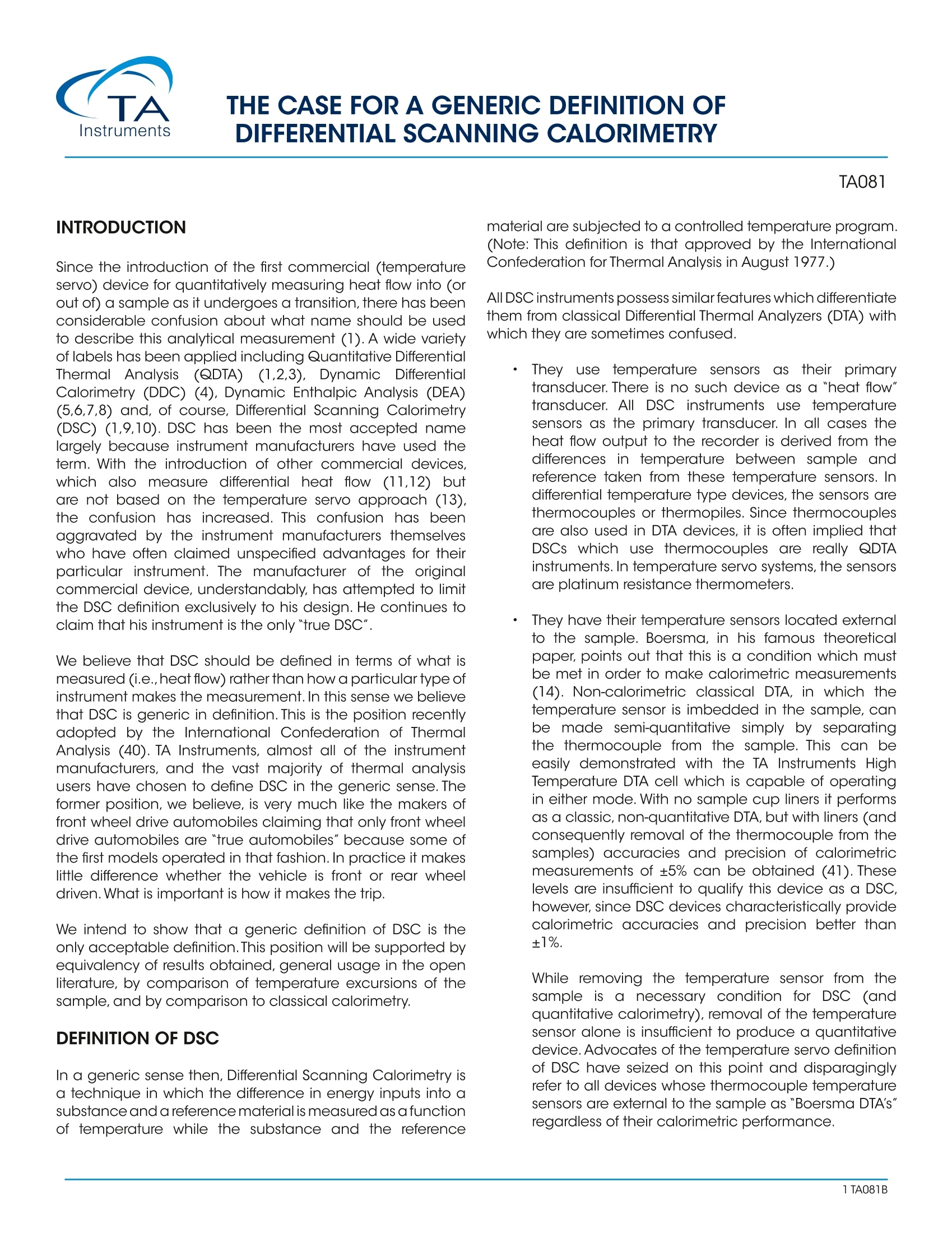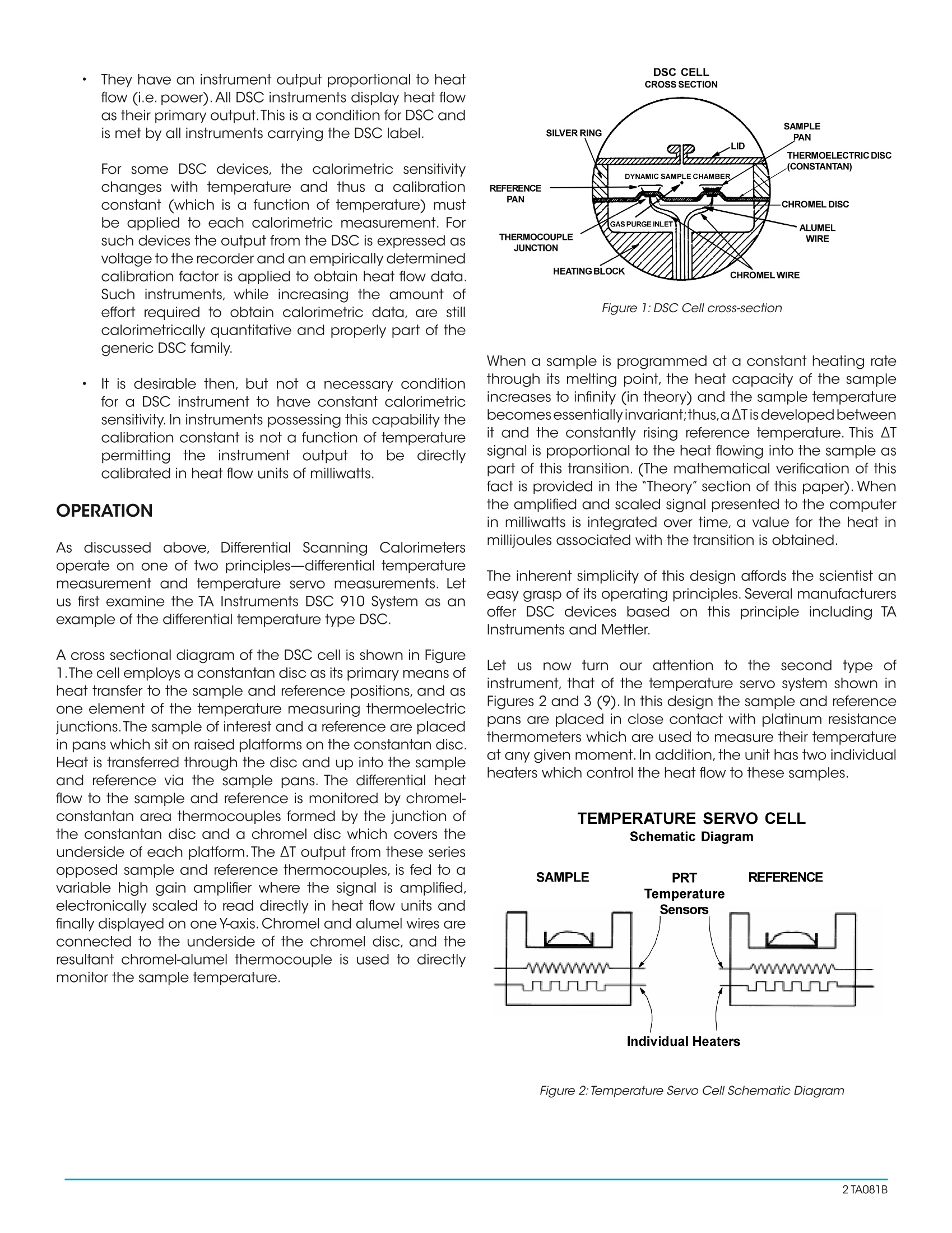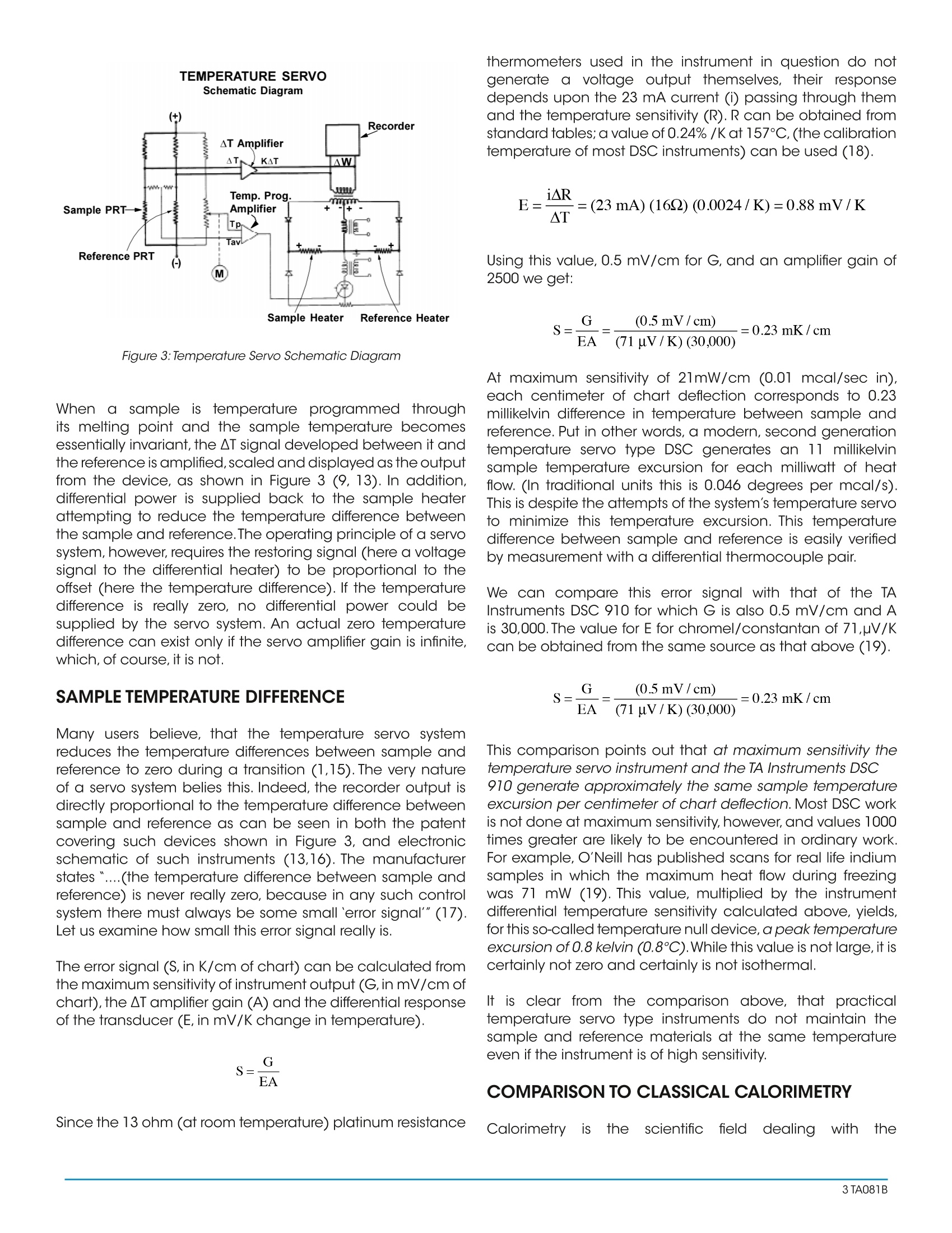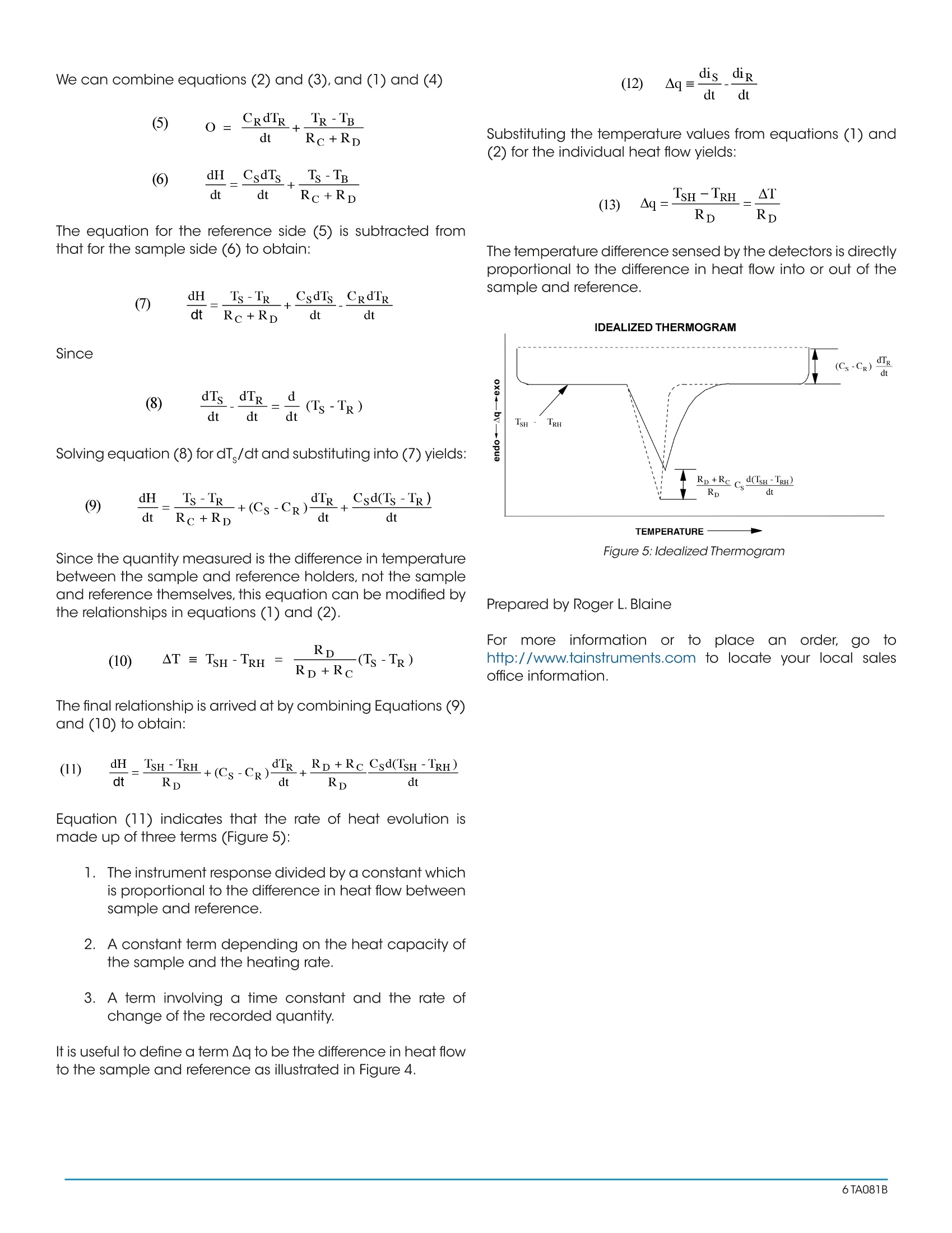
Since the introduction of the first commercial (temperature servo) device for quantitatively measuring heat flow into (or out of) a sample as it undergoes a transition, there has been considerable confusion about what name should be used to describe this analytical measurement (1). A wide variety of labels has been applied including Quantitative Differential Thermal Analysis (QDTA) (1,2,3), Dynamic Differential Calorimetry (DDC), Dynamic Enthalpic Analysis (DEA) and, of course, Differential Scanning Calorimetry (DSC). DSC has been the most accepted name largely because instrument manufacturers have used the term. With the introduction of other commercial devices, which also measure differential heat flow but are not based on the temperature servo approach , the confusion has increased. This confusion has been aggravated by the instrument manufacturers themselves who have often claimed unspecified advantages for their particular instrument. The manufacturer of the original commercial device, understandably, has attempted to limit the DSC definition exclusively to his design. He continues to claim that his instrument is the only “true DSC”.?
方案详情

THE CASE FOR A GENERIC DEFINITION OFDIFFERENTIAL SCANNING CALORIMETRY Since the introduction of the first commercial (temperatureservo) device for quantitatively measuring heat flow into (orout of) a sample as it undergoes a transition, there has beenconsiderable confusion about what name should be usedto describe this analytical measurement (1). A wide varietyof labels has been applied including Quantitative DifferentialThermal Analysis(QDTA) (1,2,3), Dynamic DifferentialCalorimetry (DDC) (4), Dynamic Enthalpic Analysis (DEA)(5,6,7,8) and, of course, Differential Scanning Calorimetry(DSC) (1,9,10). DSC has been the most accepted namelargely because instrument manufacturers have used theterm. With the introduction of other commercial devices,which also measure differential heat flow (11,12) butare not based on the temperature servo approach (13),the confusion has increased. This confusion has beenaggravated by the instrument manufacturers themselveswho have often claimed unspecified advantages for theirparticular instrument. The manufacturer of the originalcommercial device, understandably, has attempted to limitthe DSC definition exclusively to his design. He continues toclaim that his instrument is the only "true DSC". We believe that DSC should be defined in terms of what ismeasured (i.e.,heat flow) rather than how a particular type ofinstrument makes the measurement. In this sense we believethat DSC is generic in definition. This is the position recentlyadopted by the International Confederation of ThermalAnalysis (40). TA Instruments, almost all of the instrumentmanufacturers, and the vast majority of thermal analysisusers have chosen to define DSC in the generic sense. Theformer position, we believe, is very much like the makers offront wheel drive automobiles claiming that only front wheeldrive automobiles are "true automobiles"because some ofthe first models operated in that fashion. In practice it makeslittle difference whether the vehicle is front or rear wheeldriven. What is important is how it makes the trip. We intend to show that a generic definition of DSC is theonly acceptable definition. This position will be supported byequivalency of results obtained, general usage in the openliterature, by comparison of temperature excursions of thesample, and by comparison to classical calorimetry. DEFINITION OF DSC In a generic sense then, Differential Scanning Calorimetry isa technique in which the difference in energy inputs into asubstance and a reference material is measured as a functionof temperature while the substance and the reference material are subjected to a controlled temperature program.(Note: This definition is that approved by the InternationalConfederation for Thermal Analysis in August 1977.) AllDSC instruments possess similar features which differentiatethem from classical Differential Thermal Analyzers (DTA) withwhich they are sometimes confused. They use temperature sensors5astheir primarytransducer. There is no such device as a "heat flow"transducer. All DSC instrumentss use temperaturesensors as the primary transducer.In all cases theheat flow output to the recorder is derived from thedifferences in temperature between sample andreference taken from these temperature sensors. Indifferential temperature type devices, the sensors arethermocouples or thermopiles. Since thermocouplesare also used in DTA devices, it is often implied thatDSCs which use thermocouples are really QDTAinstruments. In temperature servo systems, the sensorsare platinum resistance thermometers. They have their temperature sensors located externalto the sample. Boersma, in his famous theoreticalpaper, points out that this is a condition which mustbe met in order to make calorimetric measurements(14). Non-calorimetric classical DTA, in which thetemperature sensor is imbedded in the sample, canbe made semi-quantitative simply by separatingthe thermocouple from the sample. This can beeasily demonstrated with the TA Instruments HighTemperature DTA cell which is capable of operatingin either mode. With no sample cup liners it performsas a classic, non-quantitative DTA, but with liners (andconsequently removal of the thermocouple from thesamples) accuracies and precision of calorimetricmeasurements of ±5% can be obtained (41). Theselevels are insufficient to qualify this device as a DSC,however, since DSC devices characteristically providecalorimetric accuracies and precision better than+1%. While removing the temperature sensor from thesample is a necessary condition for DSC (andquantitative calorimetry), removal of the temperaturesensor alone is insufficient to produce a quantitativedevice. Advocates of the temperature servo definitionof DSC have seized on this point and disparaginglyrefer to all devices whose thermocouple temperaturesensors are external to the sample as "Boersma DTA's"regardless of their calorimetric performance. They have an instrument output proportional to heatflow (i.e.power). All DSC instruments display heat flowas their primary output.This is a condition for DSC andis met by all instruments carrying the DSC label. For some DSC devices, the calorimetric sensitivitychanges with temperature and thus a calibrationconstant (which is a function of temperature) mustbe applied to each calorimetric measurement.Forsuch devices the output from the DSC is expressed asvoltage to the recorder and an empirically determinedcalibration factor is applied to obtain heat flow data.Such instruments, while increasing the amount ofeffort required to obtain calorimetric data, are stillcalorimetrically quantitative and properly part of thegeneric DSC family. It is desirable then, but not a necessary conditionfor a DSC instrument to have constant calorimetricsensitivity. In instruments possessing this capability thecalibration constant is not a function of temperaturepermitting the instrument output to be directlycalibrated in heat flow units of milliwatts. OPERATION As discussed above, Differential Scanning Calorimetersoperate on one of two principles-differential temperaturemeasurement and temperature servo measurements. Letus first examine the TA Instruments DSC 910 System as anexample of the differential temperature type DSC. A cross sectional diagram of the DSC cell is shown in Figure1.The cell employs a constantan disc as its primary means ofheat transfer to the sample and reference positions, and asone element of the temperature measuring thermoelectricjunctions.The sample of interest and a reference are placedin pans which sit on raised platforms on the constantan disc.Heat is transferred through the disc and up into the sampleand reference via the sample pans. The differential heatflow to the sample and reference is monitored by chromel-constantan area thermocouples formed by the junction ofthe constantan disc and a chromel disc which covers theunderside of each platform. The AT output from these seriesopposed sample and reference thermocouples, is fed to avariable high gain amplifier where the signal is amplified,electronically scaled to read directly in heat flow units andfinally displayed on one Y-axis. Chromel and alumel wires areconnected to the underside of the chromel disc, and theresultant chromel-alumel thermocouple is used to directlymonitor the sample temperature. Figure 1: DSCCell cross-section When a sample is programmed at a constant heating ratethrough its melting point, the heat capacity of the sampleincreases to infinity (in theory) and the sample temperaturebecomesessentially invariant;thus,a ▲T is developed betweenit and the constantly rising reference temperature. This ATsignal is proportional to the heat flowing into the sample aspart of this transition. (The mathematical verification of thisfTaacCt is provided in the "Theory"section of this paper). Whenthe amplified and scaled signal presented to the computerin milliwatts is integrated over time, a value for the heat inmillijoules associated with the transition is obtained. The inherent simplicity of this design affords the scientist aneasy grasp of its operating principles. Several manufacturersoffer DSC devices based on this principle including TAInstruments and Mettler. Let us now turn our attention to the second type ofinstrument, that of the temperature servo system shown inFigures 2 and 3 (9). In this design the sample and referencepans are placed in close contact with platinum resistancethermometers which are used to measure their temperatureat any given moment.In addition, the unit has two individualheaters which control the heat flow to these samples. Individual Heaters Figure 3:Temperature Servo Schematic Diagram When a sample isTtemperature programmed throughits melting point and the sample temperature becomesessentially invariant, the AT signal developed between it andthe reference is amplified, scaled and displayed as the outputfrom the device, as shown in Figure 3 (9, 13). In addition,differential power is supplied back to the sample heaterattempting to reduce the temperature difference betweenthe sample and reference.The operating principle of a servosystem, however, requires the restoring signal (here a voltagesignal to the differential heater) to be proportional to theoffset (here the temperature difference). If the temperaturedifference is really zero, no differential power could besupplied by the servo system. An actual zero temperaturedifference can exist only if the servo amplifier gain is infinite,which,of course,it is not. SAMPLE TEMPERATURE DIFFERENCE Many users believe, that the temperature servo systemreduces the temperature differences between sample andreference to zero during a transition (1,15). The very natureof a servo system belies this. Indeed, the recorder output isdirectly proportional to the temperature difference betweensample and reference as can be seen in both the patentcovering such devices shown in Figure 3, and electronicschematic of such instruments (13,16). The manufacturerstates "....(the temperature difference between sample andreference)is never really zero, because in any such controlsystem there must always be some small `error signal"(17).Let us examine how small this error signal really is. The error signal (S, in K/cm of chart) can be calculated fromthe maximum sensitivity of instrument output (G, in mV/cm ofchart), the AT amplifier gain (A) and the differential responseof the transducer (E, in mV/K change in temperature). thermometers used in the instrument in question do notgenerate a voltage output themselves, their responsedepends upon the 23 mA current (i) passing through themand the temperature sensitivity (R). R can be obtained fromstandard tables; a value of 0.24% /K at 157℃, (the calibrationtemperature of most DSC instruments) can be used (18). Using this value, 0.5 mV/cm for G, and an amplifier gain of2500 we get: At maximum sensitivity of 21mW/cm (0.01 mcal/sec in),each centimeter of chart deflection corresponds to 0.23millikelvin difference in temperature between sample andreference. Put in other words, a modern, second generationtemperature servo type DSC generates an 11 millikelvinsample temperature excursion for each milliwatt of heatflow. (In traditional units this is 0.046 degrees per mcal/s).This is despite the attempts of the system's temperature servoto minimize this temperature excursion. This temperaturedifference between sample and reference is easily verifiedby measurement with a differential thermocouple pair. We can compare this error signal with that of the TAInstruments DSC 910 for which G is also 0.5 mV/cm and Ais 30,000. The value for E for chromel/constantan of 71,uV/Kcan be obtained from the same source as that above (19). This comparison points out that at maximum sensitivity thetemperature servo instrument and the TA Instruments DSC910 generate approximately the same sample temperatureexcursion per centimeter of chart deflection. Most DSC workis not done at maximum sensitivity, however, and values 1000times greater are likely to be encountered in ordinary work.For example, O'Neill has published scans for real life indiumsamples in which the maximum heat flow during freezingwas 71 mW (19). This value, multiplied by the instrumentdifferential temperature sensitivity calculated above, yields,for this so-called temperature null device, a peak temperatureexcursion of 0.8 kelvin (0.8C).While this value is not large, it iscertainly not zero and certainly is not isothermal. 什is clear from the comparison above, that practicaltemperature servo type instruments do not maintain thesample and reference materials at the same temperatureeven if the instrument is of high sensitivity. COMPARISON TO CLASSICAL CALORIMETRY measurement of the heat or energy content of variouschemical and physical reactions. In a typical classicaladiabatic calorimetric experiment, a chemical reaction maybe carried out in a sealed container insulated from heatlosses to the outside world. From the known heat capacity(Cp) of the insulated container and its contents, and thesmall measured change in temperature (AT) of that system,the heat content of the chemical reaction (AH) can becalculated: The experiment is usually designed so that the change insystem temperature is kept small, usually several Kelvin. Undersuch conditions Cp is a constant. Such experiments have given rise to the definition of thecalorie as the unit of measurement for heat content orenergy: calorie- the amount of heat necessary to raise thetemperature of 1g of water at 15℃,1℃. In DSC, the temperature excursion of a sample seldomexceeds a few tenths of a degree. It is clear, then, that DSCinstruments operate well within the conditions of classicalcalorimetry from which thermodynamic data is almostexclusivelyobtained. This comparison of DSC to classical calorimetry needs oneother amplification. In classical adiabatic calorimetry, heatlosses from the sample to the environment are kept to aminimum. This concept is most nearly met in differentialtemperature DSC instruments since the sample is totallysurrounded by a uniform temperature environment. It is thetemperature of this environment which is programmed duringthe course of the experiment. Thus the sample "sees" onlyan environment whose temperature is very near that of itsown, thereby reducing to a minimum emissivity, atmospherethermal conductivity, and other potential heat losses. Thisproduces the remarkably stable baseline performance ofthe instruments of this type. On the other hand, temperature servo instruments suffer fromthermal conductivity and emissivity losses, thermal gradientsand thermal atmosphere convection because the samplechamber (in which the sample and reference materialsare located) is thermostated at constant temperature (20).This means that the sample sees a constantly changingenvironmental gradient during the course of an experiment.Obviously this is far afield from the standard adiabaticcalorimeter and can lead to poor baseline performanceof temperature servo instruments if not corrected for byelectronic baseline compensation. EQUIVALENCY OF RESULTS Perhaps no stronger claim can be made for a genericdefinition of DSC,than the fact that results from instruments ofthe temperature servo type and instruments of the differentialtemperature type are indistinguishable from each other. Thishas been pointed out in a previous treatise on the subject; "lt is not possible by inspection of an unlabeled thermalanalysis peak to determine which sort of apparatus wasused..."(17). Moreover, there are almost no applicationswhere one instrument obtains data and the other does not.Articles abound in the open literature on the ability of a varietyof equipment, based on differing operating principles, tomake equivalent measurements (21,22,23,24). Outstandingresearch (21,23,25) has testified to the equivalency of resultsobtained on instruments of both types. In addition, suchrespected institutions as the Drug Standards Laboratory andAmerican Society for Testing and Materials (ASTM) havestated the equivalency of results obtained on both instrumenttypes (22,26,27). GENERIC USE OF DSC Despite attempts to limit the definition of DSC to devicesbased on the temperature servo technique, DSC is usedin the open scientific literature as a generic phrase. Allother titles have faded into historical interest although oneoccasionally still sees QDTA used. C. B. Murphy's biennialreview of thermal analysis uses the phrase DSC genericallywithout differentiating the type of instrument used andincludes DSC under the DTA heading as a quantitativetechnique (28,29,30,31,32). Virtually all thermal analysis manufacturers who makequantitative calorimetric measurements, market theirinstruments under the title of Differential Scanning Calorimetryeven though operating under different principles. Theseinclude: TA Instruments, Mettler, Perkin-Elmer, and others. SUMMARY We have shown that all Differential Scanning Calorimeters,regardless of method of measurement, measure the samequantity,namely, heat flow into (or out of) a sample.It followsthat the name should be used generically and appliedto all measurements of this type rather than limited tomeasurements made on a particular instrument.This positionis supported by: equivalence of measurement general usage in the open literature similar temperature excursions of the sample comparison to classical calorimetry 1 E. S Watson, M.J. O'Neill, J. Justin, and N. Brenner, Anal.Chem., 36,1233 (1964). 2A. P.Gray,Am. Lab.,3,43(1971).34 ( H.E. Bair, Polym.Eng. Sci., 10, 247 (1 9 70). ) S. M. Ellerstein,Anal.Calor., R. S. Porter and J. F. Johnson(eds.), Plenum, 279 (1968).. 5. R.F. Schwenker and J.C.Whitwell,Anal. Calor.,R. S. Porterand J.F Johnson (eds.), Plenum, 249 (1968). 6. V. Crescenzi and F. Delbin, Intern. J. Protein Res., 3,57(1971). 7B. Miller,J.Appl. Poly. Sci.,11, 2343 (1967).89 G.Beech,J.Chem.Soc.,(A), 1903 (1969). W. W. Wendlandt, Thermal Methods of Analysis, JohnWiley 193 (1974). 10.T.C. Daniels,Thermal Analysis, John Wiley 122 (1973). 11.[R. A. Baxter, Thermal Analysis, R. F. Schwenker, Jr., and P.D.Garn (eds.),Academic Press,65 1969. 12.D.J.David,Anal.Chem., 36,2162(1964). ( 13. E .S.Watson and M.J.O'Neill,U.S.Patent 3,26 ,2 3 O , 5 4 , 84 (1966). ) ( S.L. Boersma,J.Am. Ceramic Soc.,38,281 (1955). ) J. L. McNaughton and C. T. Mortimer, Thermochemistryand Thermodynamics, H. A.Skinner (ed), Butterworth, 1(1975). Perkin-Elmer DSC-2 Manual. ( P erkin-Elmer, Thermal Analysis N ewsletter No.9 ( 1 970). ) ( H .F. Stimson, J.F . Swindells and R.E . Wilson, American Institut e of Physics Handbook, D . E. Gray(ed) , McGraw- Hill,4- 1 1963. ) 19.M.J.O'Neill,Anal. Chem.,47,630 (1975). 20.P. L. Privalov, V.V. Plotnikov, and V. V. Filimonov, J. Chem.Thermodynamics,7,41 (1975). 21.A. Doelman, A.R. Greggs, E.M. Barrall Il, Paper No.77, American Chemical Society NationalMeeting,September 1,1976. 22.L.T. Grady, S. E Hays, R. H. King, H.R. Klein, W. J. Mader, D. K.Wyatt and R. O. Zimmerer, J. Pharm. Sci.,62,456 (1973). 23.E.F. Palermo and J.Chiu,Thermochim.Acta, 14,1(1976).24.W.J. Miller, W.H. Foester and FE. Freeberg,J.Am.Oil Chem.Soc.,46,341 (1969). 25.B. Wunderlich, Physical Methods of Chemistry,, A.Weissberger(ed),Vol.1, Part 5, John Wiley, 427 (1971). 26.ASTM Method D-3417"Measurement of Heats of Fusionand Crystallization of Polymers by Thermal Analysis" 27.ASTMMethodD-3418B"Measurement of TransitionTemperatures of Polymers by Thermal Analysis. 28..(C. B.Murphy,Anal. Chem., 48, 341 R(1976). 29.. C. B. Murphy,Anal. Chem., 46,451R (1974). 30. C. B. Murphy,Anal. Chem.,44,513R (1972). 31.. C. B. Murphy,Anal. Chem.,42,268R (1970). 32..C. B. Murphy,Anal. Chem.,40,380R (1968). APPENDIX THEORY The theoretical basis for the TA Instruments DSC 910 is welldocumented in Baxter’s work on the subject (11). A portionof his work is reproduced and expanded here for the sake ofcompleteness: The essential parts of the DSC are a sample at temperatureT, its container at temperature Tsw,and a temperatureprogrammed source at temperature TB. Heat will flowbetween these positions at a rate di/dt depending onthe temperatures involved and the thermal resistancesconnecting the positions. The sample and its containerhave a heat capacity C. Since the calorimeter operatesdifferentially, a similar description can be developed for thereference side of the cell. Figure 4 illustrates this descriptionschematically. Figure 4: Calorimetric Schematic If we make the simplifying assumptions that the calorimeteris symmetrical and that thermal resistances are identical onthe reference and sample sides at any given temperature;that the temperatures of the sample, reference, and theircontainers are uniform; and that the flow of heat from sampleto reference can be neglected, then the response of thecalorimeter can be described with the aid of heat balanceequations and thermal ohm's law relationships. lf we assume a sample undergoing an exothermic transitiongiving up heat energy at a rate dH/dt, then the appropriateequations are: Equation (4) indicates that the heat evolved by the samplegoes either into heating the sample or is dissipated to thesurroundings. We can combine equations (2) and (3), and (1)and (4) The equation for the reference side (5) is subtracted fromthat for the sample side (6) to obtain: Since Solving equation (8) for dT,/dt and substituting into (7)yields: Since the quantity measured is the difference in temperaturebetween the sample and reference holders, not the sampleand reference themselves, this equation can be modified bythe relationships in equations (1) and (2). The final relationship is arrived at by combining Equations (9)and (10) to obtain: Equation (11) indicates that the rate of heat evolution ismade up of three terms (Figure 5): 1.. 1The instrument response divided by a constant whichis proportional to the difference in heat flow betweensample and reference. 2. A constant term depending on the heat capacity ofthe sample and the heating rate. 3. A term involving a time constant and the rate ofchange of the recorded quantity. lt is useful to define a term Aq to be the difference in heat flowto the sample and reference as illustrated in Figure 4. Substituting the temperature values from equations (1) and(2) for the individual heat flow yields: The temperature difference sensed by the detectors is directlyproportional to the difference in heat flow into or out of thesample and reference. Figure 5: Idealized Thermogram Prepared by Roger L. Blaine For more information or to place an order, go tohttp://www.tainstruments.com to locate your local salesoffice information. A Since the introduction of the first commercial (temperature servo) device for quantitatively measuring heat flow into (or out of) a sample as it undergoes a transition, there has been considerable confusion about what name should be used to describe this analytical measurement (1). A wide variety of labels has been applied including Quantitative Differential Thermal Analysis (QDTA) (1,2,3), Dynamic Differential Calorimetry (DDC), Dynamic Enthalpic Analysis (DEA) and, of course, Differential Scanning Calorimetry (DSC). DSC has been the most accepted name largely because instrument manufacturers have used the term. With the introduction of other commercial devices, which also measure differential heat flow but are not based on the temperature servo approach , the confusion has increased. This confusion has been aggravated by the instrument manufacturers themselves who have often claimed unspecified advantages for their particular instrument. The manufacturer of the original commercial device, understandably, has attempted to limit the DSC definition exclusively to his design. He continues to claim that his instrument is the only “true DSC”.
确定






还剩4页未读,是否继续阅读?
TA仪器为您提供《材料中差示扫描量热检测方案(差示扫描量热)》,该方案主要用于其他中差示扫描量热检测,参考标准--,《材料中差示扫描量热检测方案(差示扫描量热)》用到的仪器有
相关方案
更多
该厂商其他方案
更多








